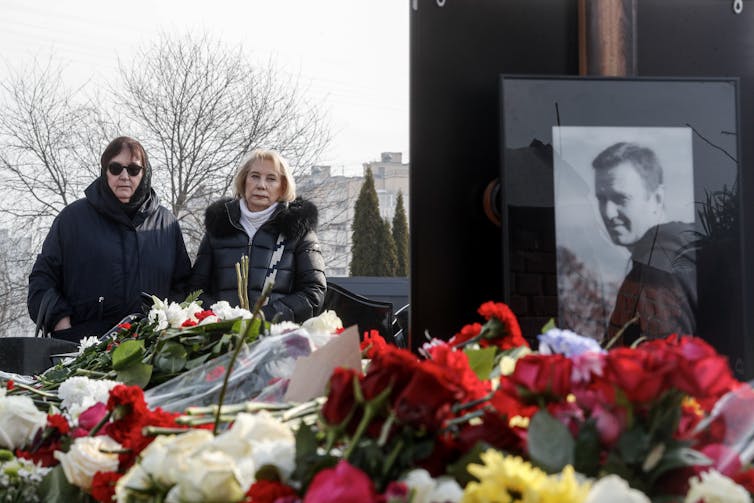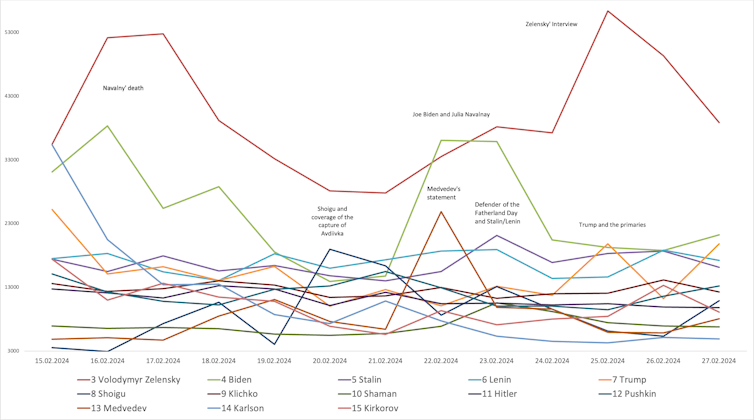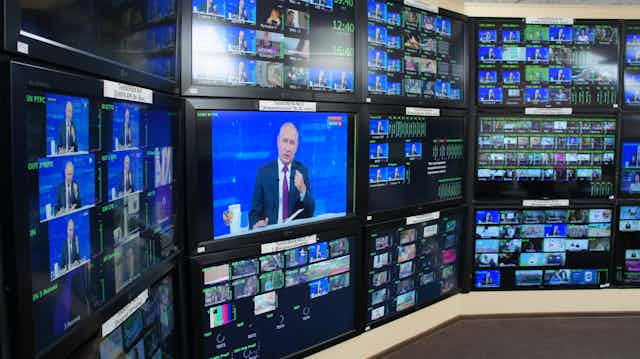The sudden death of Russian opposition figurehead Alexei Navalny in a prison camp in Russia’s Arctic circle on February 16 marked a significant moment in Russian public discourse. Navalny’s demise led to a substantial increase in online discussion about someone other than Vladimir Putin.
There was a 14-fold rise in mentions of Navalny on social media as he temporarily outdid Vladimir Putin – something very rare and an indication of the public shock and concern his death had caused.
I wanted to find out to what extent Putin’s presence on Russian social media compared to his dominance in broadcast media. I used a website called BrandAnalytics to collect daily data on the mentions of prominent public figures in Russia from February 15 to 27.
Since the Kremlin banned Meta from operating in Russia at the end of 2022, the social media landscape has been dominated by UAE-based platform Telegram as well as local Russian platforms including VKontakte and Odnoklassniki. Telegram’s surge as the primary digital platform follows the migration of users from platforms such as Instagram, Facebook, and Twitter that are restricted in Russia.
The graph below – which is generated from that data – clearly illustrates the overwhelming dominance of Vladimir Putin in the social media landscape. This dominance is maintained through a combination of state-controlled media, numerous government officials who frequently post content featuring him, and the assistance of bots designed to amplify mentions of his persona. This ensures his pervasive presence in Russian public discourse, reflecting his extensive influence over the media landscape.
Daily mentions of the top 15 people on Russian social media:“

But if there could be said to be a challenger for attention on Russian social media platforms it would be Alexey Navalny. If you look at the table below, which examines social media mentions in April 2021 – when Navalny returned to Russia after recuperating from Novichok poisoning and was arrested at the airport, tried and imprisoned – you can see that there was a high level of interest.
That interest was sustained for several months as people followed the story of his arrest and trial. The president still dominated social media – but you’d expect that. But, unusually, Putin scored less than double the number of mentions that Navalny achieved. Given the factors that artificially inflate Putin’s numbers (government officials, bots, etc) it shows that Navalny remained a strong presence in people’s minds.
Top five people mentioned on Russian social media, April 2021 and February 2024:

If you dig deeper you can identify four primary groups of personalities that recur in Russia’s top 50. To make life easier, I’ve on the top 15 people being mentioned on social media. It immediately becomes clear that the top people being talked about on Russian social media platforms are world leaders – dominated by Putin, but other popular figures for discussion include Joe Biden, Emmanuel Macron and Donald Trump.
Below that, but also popular figures for discussion in the framework of the daily news are senior Russian politicians such as former president Dmitry Medvedev, who is now the deputy head of Russia’s national security council, and defence minister Sergei Shoigu. Other popular categories for discussion are historical figures such as the Soviet leaders Josef Stalin and Vladimir Lenin as well as the Russian poet and playwright, Alexander Pushkin.
The next tier of personalities comprises contemporary cultural figures such as the Bulgarian-born Russian pop singer Philipp Kirkorov, and singer songwriter Yaroslav Yuryevich Dronov – better known by his stage name Shaman) – both of whom are known for their support of Russia’s war on Ukraine.
Politics to the fore
While the primary group, led by Putin himself, features regular spikes for the likes of Biden, Trump and Macron, newsworthy Ukrainians including the president, Volodymyr Zelensky and the mayor of Kyiv, former boxer Vitali Klitschko, also feature regularly.

In the context of the war in Ukraine, Zelensky and Biden are often framed by users to support a narrative of external threat. This also helps legitimise Putin’s regime as he is presented as the person protecting Russians from the threats presented by these figures.
Biden’s meeting with Navalny’s widow, Yulia Navalnaya, on February 22 – days after her husband’s death – also supported this notion in that many people posting saw this as proof that the west was ganging up with the regime’s enemies.
Among Russian politicians in the top-15 mentions, only Medvedev and Shoigu tend to get a look in. Their mentions tend to spike when they say something newsworthy – for example Medvedev’s speech on February 22 when he said Russia would push to occupy large chunks of Ukraine and possibly even Kyiv. Shoigu’s name spiked around the time he was getting credit for Russia’s capture of the key Ukrainian town of Avdiivka.
But even so, these figures achieve at most 8,000 to 9,000 mentions – 23 times fewer than the sorts of numbers achieved by Putin. It highlights the lack of visible political alternatives to Putin’s leadership – or even an accepted succession – in the eyes of the Russian people.
An eye on history
The regular presence of key figures from Russian history – Lenin, Stalin but also the bogeyman of the second world war, Adolf Hitler – is suggestive of Russia’s complex relationship with its past. Sentiments of nostalgia, national pride and critical reflection are intertwined and influence current political discourse.
Regular reminders of Hitler and the Nazis plays into one of the favourite themes of Putin’s speeches, which is that Nazism once again threatens the peace-loving people of Russia, particularly from Ukraine, whose leadership the Russian president regularly condemns as a "gang of Nazis”.
Daily mentions of top 13 people on Russian social media not including Putin and Navalny:

It is, of course, very difficult to separate regular social media discussion from Kremlin-sponsored content. But even so, if social media mentions are any indication of political sentiment in Russia, it’s not hard to see how Putin has just manipulated his way to a fifth term of office.

